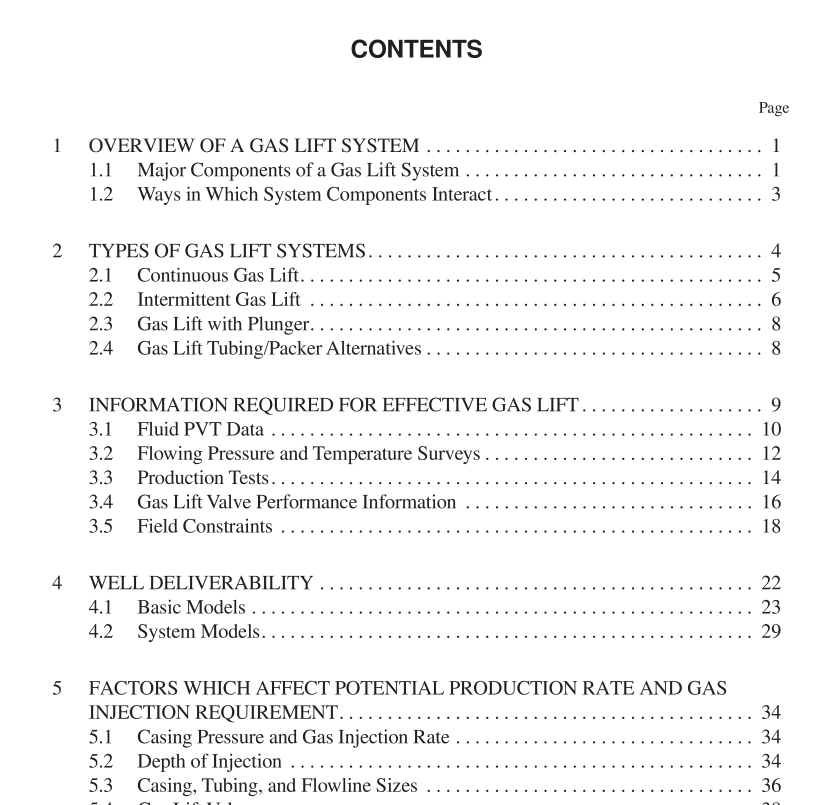API RP 11V8 pdf download

API RP 11V8 pdf download.Recommended Practice for Gas Lift System Design and Performance Prediction
An orifice can be used in lieu of a valve at the expected depth of injection. The orifice consists of the orifice (port) and the reverse flow check, but does not have a bellows and stem, so it is not a valve that can open or close. Usually, the gas lift valve allows the injection gas to flow from the tubing-casing annular space into the production tub- ing. But alternatively, a gas lift valve can be installed to allow the gas to flow from the tubing into the annular space where it mixes with the production fluids coming from the reservoir. This is done when the gas and oil flow rates are high and require the annular area to minimize pressure loss. Casing corrosion due to annular flow is difficult to remedy, thus flow up the casing annulus is usually not recommended and often prohibited.
The multiphase gas-liquid flow from the well is transported either directly or through a gathering manifold to a separator station. Pipeline (flowline) sizing is dependent on the connec- tion method: • Directly connected flowlines—the diameter of the gas/ oil/water pipeline depends on the flow rate, topography, and distance traveled, and it is usually equal to or greater than the diameter of the production tubing. Modeling of production rate vs. wellhead pressure for several flow- line sizes aids in selecting an optimum size. • Manifold connected flowlines—in large fields where the wellheads are distant from the separation plant, gathering manifolds can minimize total pipeline length. The wellhead to manifold connection is sized as stated above. From the manifold, usually two flow lines con- nect with the flow station. One is the production pipe- line, used to transport the commingled flow from all the wells (except for the one being tested), and is sized for total flow including future water increases plus lift gas. The other is a smaller diameter test line and is used to connect only one of the wells to the test separator where its fluid and gas production is measured. • A test separator located at the manifold is an option to avoid the need for the small test line and associated purging methods for long test lines. From the separator flow station, the low-pressure gas is returned to the compression plant to complete the cycle.
2.2 INTERMITTENT GAS LIFT
Intermittent gas lift applies large rates of gas for a short time duration. The production cycle consists of a liquid slug followed by a gas slug, followed by tail gas until the inter- mittent cycle is repeated. The large rate of gas and low rate of liquid causes the flowing gradient to be approximately 0.05 psi/ft, after the slugs have surfaced, thus the method is applicable to low SBHP wells. However, the lift effective- ness is diminished and more gas is required, in terms of standard cubic ft (scf) of lift gas per stock tank barrel (bbl) of liquid produced. The injection gas can be controlled by a choke or by a control valve.In Figure 2-2 a complete cycle of intermittent gas lift oper- ation is illustrated. The cycle phases are: 1. The operating valve is closed, the standing valve is open, and fluid from the formation accumulates inside the tubing above the operating valve. 2. The controller and operating valve are open, the injec- tion gas enters into the tubing and displaces the liquid slug toward the surface. At this time, the standing valve closes, preventing high-pressure gas flow into the formation. 3. The controller closes, which stops the inflow of gas into the annular space, and the operating valve will close when the annular pressure reaches the valve clos- ing pressure. 4. If choke control is used, then the choke constraint (choke area is smaller than the valve port area) causes the gas injection pressure to decline to the valve clos- ing pressure. This method minimizes intermittent cycle disruption of other wells.









